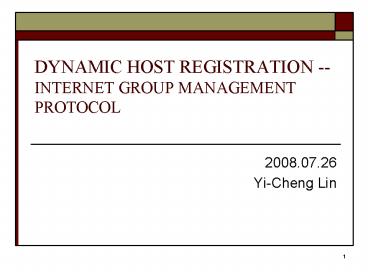DYNAMIC HOST REGISTRATION INTERNET GROUP MANAGEMENT PROTOCOL - PowerPoint PPT Presentation
1 / 23
Title:
DYNAMIC HOST REGISTRATION INTERNET GROUP MANAGEMENT PROTOCOL
Description:
IGMP is used by IPv4-based receivers. The latest version at press time was Version 3. ... Number of Sources field indicates how many source addresses are ... – PowerPoint PPT presentation
Number of Views:33
Avg rating:3.0/5.0
Title: DYNAMIC HOST REGISTRATION INTERNET GROUP MANAGEMENT PROTOCOL
1
DYNAMIC HOST REGISTRATION -- INTERNET GROUP
MANAGEMENT PROTOCOL
- 2008.07.26
- Yi-Cheng Lin
2
Outline
- INTRODUCTION
- IGMP MESSAGES
- IGMPv3 MESSAGES
- IGMP OPERATION
- PROTOCOL DETAILS FOR IGMPv2
- IGMP SNOOPING SWITCHES
3
INTRODUCTION
- IGMP is used by host receivers to join or leave a
multicast host group. - IGMP is used by IPv4-based receivers.
- The latest version at press time was Version 3.
- IGMPv3 supports receivers that explicitly signal
sources from which they wish to receive traffic.
4
INTRODUCTION
- Specifically, IGMPv3 is employed by hosts to
signal channel access in SSM (Source Specific
Multicast ). - Benefits of SSM
- Optimized access bandwidth utilization
- Risk reduction
5
IGMP MESSAGES
- In Version 1 , there are two types of IGMP
messages MQ and MR. - IGMPv2 message types are MQ,MR, and Leave Group
(LG). - MQ generic (general MQ), specific
(group-specific MQ).
MQ
router
receiver
MR
6
IGMP MESSAGES
- The IGMP messages for IGMPv2
7
IGMPv3 MESSAGES
- Version 3 allows receivers to subscribe to or
exclude a specific set of sources within a
multicast group, rather than just an individual
source (this is called, as noted, source specific
multicast). - With this feature, IGMPv 3 adds support for
source filtering. - IGMPv3 is not widely implemented as of press
time.
8
IGMPv3 MESSAGES
- Receivers signal membership to a multicast host
group in the following two modes - INCLUDE mode.
- EXCLUDE mode.
- To support this capability the membership query
packet (type of 0x11) has been changed in
addition, a new packet type of 0x22 has been
added.
9
IGMPv3 MESSAGES
- In IGMPv3 there are the following three variants
of the Query message - general query
- group-specific query
- group-and-source-specific query
10
IGMPv3 MESSAGES
- The Max Resp Code field specifies the maximum
time allowed before sending a responding report. - Represented in units of 1/10 s and is derived
from the maximum response code. - lt 128, the value of the maximum response time
- Max Resp Code gt128, Max Resp Code represents a
floating-point
11
IGMPv3 MESSAGES
- If Max Resp Code gt 128
- Ex assume that the value of the maximum response
code is decimal 178. - 10110010
- Byte 0 1
- Exp 011
- Mant 0010
- The subsequent calculations are
- ( Mant 0x10) (001010000) 10010
- Expt11 011 11 110 (basically, 3 3 6 in
base 10, or 110 in base 2) - Therefore, when the maximum response code is
decimal 178, the maximum response time is 1152
tenths of a second.
12
IGMPv3 MESSAGES
- The QRV field (Queriers Robustness Variable)
carries a parameter that is used in tuning timer
values for expected packet loss. - The QQIC field (Queriers Query Interval Code)
carries a value specifying the query interval, in
seconds, used by the originator of this query. - Number of Sources field indicates how many source
addresses are contained within the Query message.
13
IGMPv3 MESSAGES
- As noted earlier, IGMPv3 adds a new type of 0x22
to support the IGMPv3 MR. - MRs are sent by IP systems to report (to
neighboring routers) the current multicast
reception state.
14
IGMPv3 MESSAGES
- The Record Type field indicates whether the group
record type is a current-state,
filter-mode-change, or source-list-change record. - Version 3 reports are sent with an IP destination
address of 224.0.0.22, to which all
IGMPv3-capable multicast routers listen. - Because of its higher complexity, IGMPv3 is not
universally supported by all the receiver hosts,
IGMPv2 is more common, especially in IPTV
applications
15
IGMP OPERATION
- IGMP is an asymmetric protocol.
- Host Operations
- To receive multicast datagrams, a host must join
a group. To join a group, the host sends an IGMP
membership report packet through an attached
interface.
16
IGMP OPERATION
- Multicast Router Operations
- Multicast routers listen to all multicast
addresses to detect membership reports. - 1. receiver (host) signals to join a group,
- 2. creates an entry in the local group database.
- 3. To verify group membership, multicast routers
regularly send an IGMP Query message.
17
IGMP OPERATION
- Switches Using IGMP Snooping
- IGMP snooping utilizes a router to send out IGMP
Query messages to identify potentially interested
receivers. - Membership reports are returned to the router,
which builds a mapping table of the group and
associates forwarding filters for the member
port. - If no router is available, some switches can take
on the query function. RFC 4541 provides
mechanisms to allow switches to snoop on IGMP
traffic. - This reduces the amount of unnecessary multicast
traffic flooding to locally attached networks
that have no active receivers.
18
IGMP OPERATION
- Figure 4.5 illustrates the process at a
macrolevel here receivers seek to access a video
multicast from an IPTV source.
19
PROTOCOL DETAILS FOR IGMPv2
- Receiver (Host) State Diagram
- A host may be in one of the following three
possible states with respect to any single IP
multicast group on any single network interface
20
PROTOCOL DETAILS FOR IGMPv2
- Router State Diagram
21
PROTOCOL DETAILS FOR IGMPv2
- In addition, to keep track of which groups have
members, a router may be in one of the four
possible states with respect to any single IP
multicast group on any single attached network.
22
PROTOCOL DETAILS FOR IGMPv2
23
- Thank you































